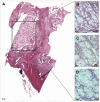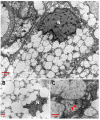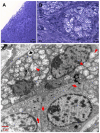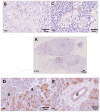Novel Ultrastructural Insights into the Clear-Cell Carcinoma of the Pancreas: A Case Report
- PMID: 38673897
- PMCID: PMC11049960
- DOI: 10.3390/ijms25084313
Novel Ultrastructural Insights into the Clear-Cell Carcinoma of the Pancreas: A Case Report
Abstract
Pancreatic cancer, most frequently as ductal adenocarcinoma (PDAC), is the third leading cause of cancer death. Clear-cell primary adenocarcinoma of the pancreas (CCCP) is a rare, aggressive, still poorly characterized subtype of PDAC. We report here a case of a 65-year-old male presenting with pancreatic neoplasia. A histochemical examination of the tumor showed large cells with clear and abundant intracytoplasmic vacuoles. The clear-cell foamy appearance was not related to the hyperproduction of mucins. Ultrastructural characterization with transmission electron microscopy revealed the massive presence of mitochondria in the clear-cell cytoplasm. The mitochondria showed disordered cristae and various degrees of loss of structural integrity. Immunohistochemistry staining for NADH dehydrogenase [ubiquinone] 1 alpha subcomplex, 4-like 2 (NDUFA4L2) proved specifically negative for the clear-cell tumor. Our ultrastructural and molecular data indicate that the clear-cell nature in CCCP is linked to the accumulation of disrupted mitochondria. We propose that this may impact on the origin and progression of this PDAC subtype.
Keywords: clear-cell primary adenocarcinoma; extracellular vesicles; mitochondria; pancreas; transmission electron microscopy.
Conflict of interest statement
The authors declare no conflicts of interest.
Figures








Similar articles
-
Primary clear cell ductal adenocarcinoma of the pancreas: a case report and clinicopathologic literature review.J Cancer Res Ther. 2014 Jul-Sep;10(3):773-6. doi: 10.4103/0973-1482.136043. J Cancer Res Ther. 2014. PMID: 25313783
-
A case of osteoclast-like giant cell tumor of the pancreas with ductal adenocarcinoma: histopathological, immunohistochemical, ultrastructural and molecular biological studies.J Korean Med Sci. 2005 Jun;20(3):516-20. doi: 10.3346/jkms.2005.20.3.516. J Korean Med Sci. 2005. PMID: 15953882 Free PMC article.
-
Clear cell ductal adenocarcinoma of pancreas: a case report and review of the literature.Arch Pathol Lab Med. 2004 Jun;128(6):693-6. doi: 10.5858/2004-128-693-CCDAOP. Arch Pathol Lab Med. 2004. PMID: 15163226 Review.
-
TGFB1-induced autophagy affects the pattern of pancreatic cancer progression in distinct ways depending on SMAD4 status.Autophagy. 2020 Mar;16(3):486-500. doi: 10.1080/15548627.2019.1628540. Epub 2019 Jun 17. Autophagy. 2020. PMID: 31177911 Free PMC article.
-
Solid type clear cell carcinoma of the pancreas: differential diagnosis of an unusual case and review of the literature.Virchows Arch. 2007 Jun;450(6):719-26. doi: 10.1007/s00428-007-0416-5. Epub 2007 Apr 24. Virchows Arch. 2007. PMID: 17453235 Review.
References
-
- Krebs A.M., Mitschke J., Lasierra Losada M., Schmalhofer O., Boerries M., Busch H., Boettcher M., Mougiakakos D., Reichardt W., Bronsert P., et al. The EMT-activator Zeb1 is a key factor for cell plasticity and promotes metastasis in pancreatic cancer. Nat. Cell Biol. 2017;19:518–529. doi: 10.1038/ncb3513. - DOI - PubMed
Publication types
MeSH terms
LinkOut - more resources
Full Text Sources
Medical

